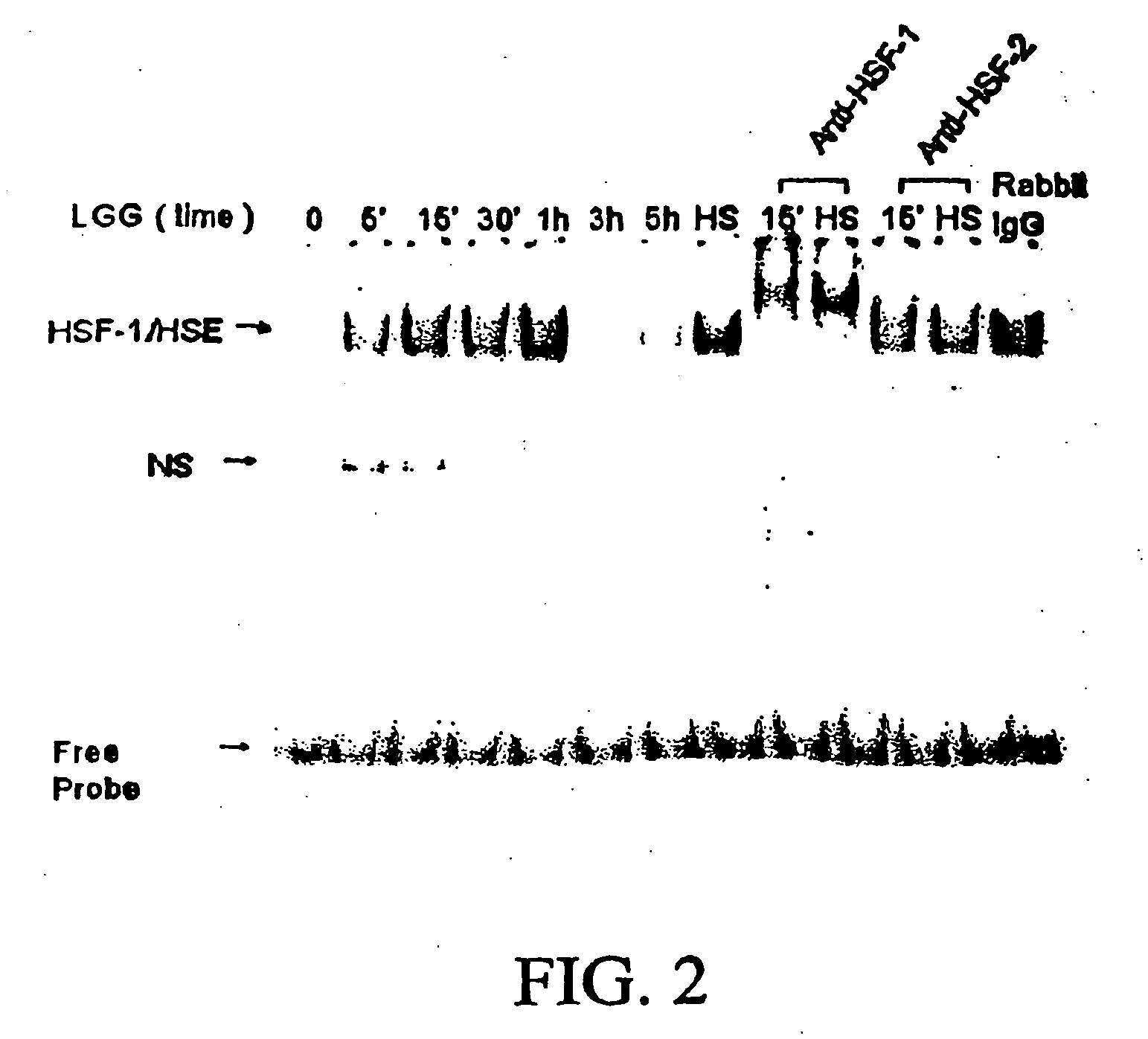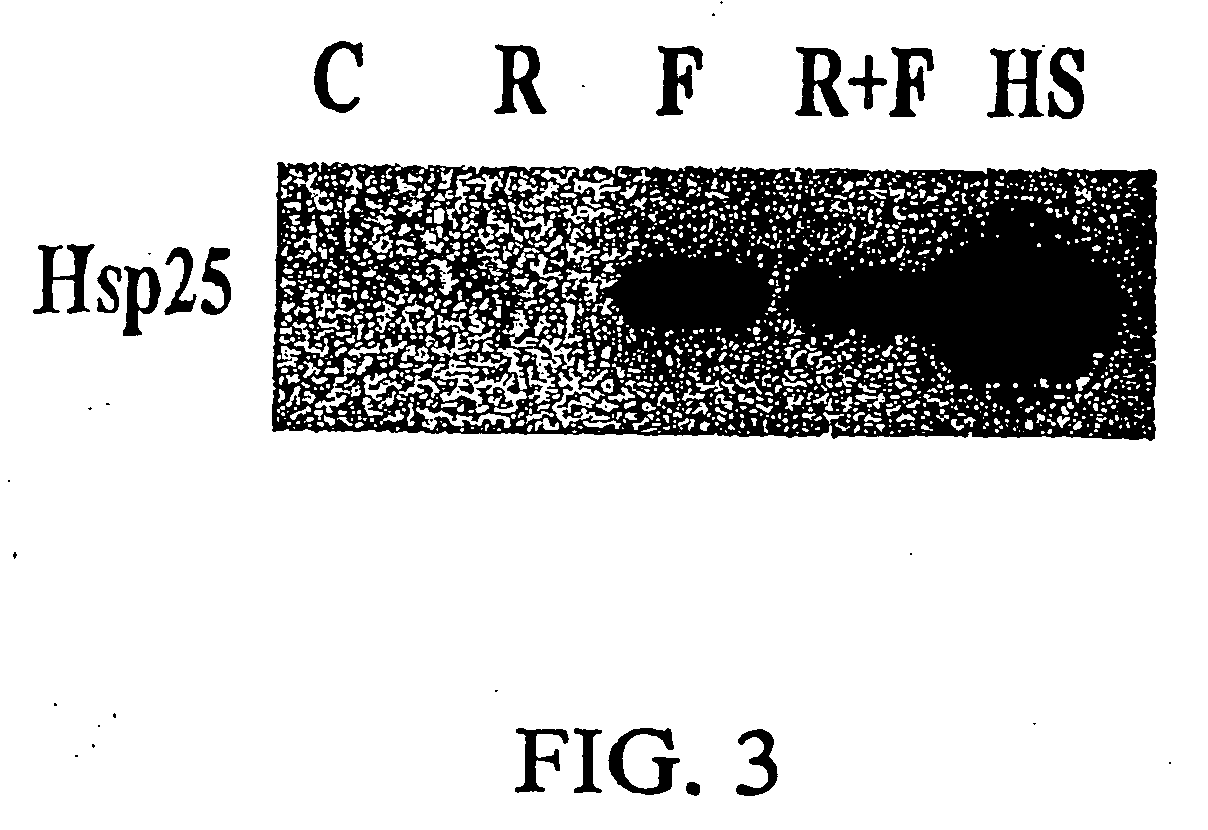Probiotic compounds from Lactobacillus GG and uses therefor
- Summary
- Abstract
- Description
- Claims
- Application Information
AI Technical Summary
Benefits of technology
Problems solved by technology
Method used
Image
Examples
example 1
[0121] Cultures
[0122] Tissue Culture. YAMC (young adult mouse colon) cells are a conditionally immortalized mouse colonic intestinal epithelial cell line derived from the Immortimouse Whitehead et al., 1993). These cells express a transgene of a temperature-sensitive SV40 large T antigen (tsA58) under control of an interferon-gamma sensitive portion of the MHC class II promoter (Whitehead et al., 1993, incorporated herein by reference). This special feature allows YAMC cells to be cultured under non-permissive (non-transformed) conditions at 37° C. in the absence of interferon-gamma (IFN-γ). YAMC cells were maintained under permissive conditions (33° C.) in RPMI 1640 medium with 5% (vol / vol) fetal bovine serum, 5 U / ml murine IFN-γ (GibcoBRL, Grand Island, N.Y.), 50 μg / ml streptomycin, and 50 U / ml penicillin, supplemented with ITS-X Premix (Collaborative Biomedical Products, Bedford, Mass.).
[0123] Under non-permissive (non-transformed) conditions at 37° C. in the absence of IFN-γ, ...
example 2
[0132] LGG-CM Induces Expression of Hsp25 and Hsp72 in Intestinal Epithelial Cells—Western Analyses
[0133] Intestinal epithelial cells were treated with conditioned media from the probiotic LGG and then assayed for inducible heat shock protein expression. For Western blot analyses of expression, cells were washed twice and then scraped in ice-cold PBS (137 mM NaCl, 2.7 mM KCl, 8 mM Na2HPO4, pH 7.4). Cells were pelleted (14,000×g for 20 seconds at room temperature), then resuspended in ice-cold lysis buffer (10 mM Tris, pH 7.4, 5 mM MgCl2, 50 U / ml each of DNAse and RNAse, plus complete protease inhibitor cocktail (Roche Molecular Biochemicals, Indianapolis, Ind.)). Protein concentrations were determined using the bicinchoninic acid procedure (Smith et al., 1985). Samples were heated to 75° C. for 5 minutes after addition of 3× Laemmli Stop buffer, then stored at −80° C. until use.
[0134] Twenty micrograms of protein per lane were resolved on 12.5% SDS-PAGE. Samples were transferred i...
example 3
[0138] MAP Kinase Assays
[0139] To assess the participation of a signal transduction pathway in the Hsp expression induced by LGG-CM, MAP kinase assays were performed. For these assays, cells were plated at a density of 7.5×105 cells per 100 mm dish. Cells were treated with LGG-CM and this was removed after 15 minutes and replaced with fresh RPMI medium. Cells were then harvested immediately after treatment with LGG-CM for Western blot analyses (MAP kinase phosphorylation). PVDF membranes were blocked in 3% weight / volume bovine serum albumin in TBS-Tween for one hour at room temperature. Primary antibodies were added to TBS-Tween and incubated overnight at 4° C. with antibodies specific for p38 MAP kinase (MAPK) #9212, Cell Signaling, Beverly, Mass.), phospho-p38 MAPK (#9211S, Cell Signaling), p44 / 42 MAPK (#9102, Cell Signaling), phospho-p44 / 42 ERK MAPK (#9101S), SAPK / JNK (#9252, Cell Signaling), and phospho-SAPK / JNK (#9251S, Cell Signaling). The phosphorylated form of the kinase in...
PUM
| Property | Measurement | Unit |
|---|---|---|
| Time | aaaaa | aaaaa |
| Atomic weight | aaaaa | aaaaa |
| Fraction | aaaaa | aaaaa |
Abstract
Description
Claims
Application Information
 Login to View More
Login to View More - R&D
- Intellectual Property
- Life Sciences
- Materials
- Tech Scout
- Unparalleled Data Quality
- Higher Quality Content
- 60% Fewer Hallucinations
Browse by: Latest US Patents, China's latest patents, Technical Efficacy Thesaurus, Application Domain, Technology Topic, Popular Technical Reports.
© 2025 PatSnap. All rights reserved.Legal|Privacy policy|Modern Slavery Act Transparency Statement|Sitemap|About US| Contact US: help@patsnap.com



